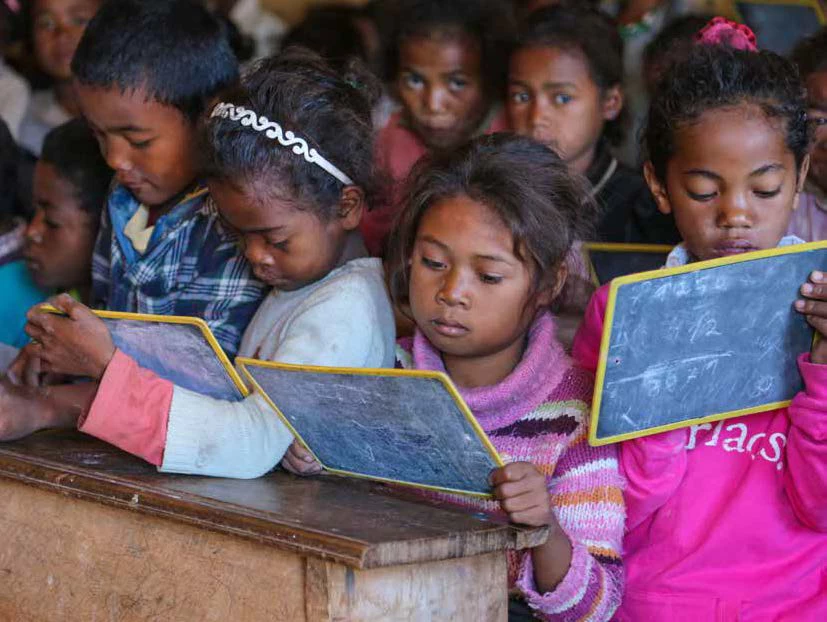 如何确保儿童在灾害期间得到妥善照看
如何确保儿童在灾害期间得到妥善照看
We live in a turbulent world, marred by man-made crises and exposed to intensifying natural disasters and climate challenges. This leaves children and youth vulnerable to major risks across the globe. Each year, disasters interrupt the schooling of approximately 175 million children. Since 2013, conflicts in Yemen, Syria, Ukraine, Bangladesh, and other countries have forced millions to move from their homes and find safer places. A significant share of those displaced are children of preschool and school-age. If the education sector is poorly prepared to recover quickly from a major disaster or crisis, the impact on these children can be severe and longterm.
Education plays a critical role in protecting communities from new risks and vulnerabilities that arise in the aftermath of a disaster or crisis. Schools can provide safe spaces, normalize the daily activities of children, and provide life-saving and wellbeing, knowledge and skills. Education also enhances people’s resilience and encourages their recovery and active involvement in activities that reduce exposure to further risks. It is therefore important that governments respond quickly to restore the provision of education, with the longer-term ambition of building back better.
Drawing on our experience working on resilient education across the globe, the World Bank and the Global Facility on Disaster Reduction and Recovery (GFDRR) have recently published an education recovery guidance note. The note provides critical insights that government officials, the private sector and other development practitioners should take into account in the recovery and reconstruction of the education sector over three distinct phases of action.
The response phase involves the provision of emergency services and public assistance during or immediately after a disaster. The purpose is to save lives, reduce health impacts, ensure public safety, and meet the basic subsistence needs of the people affected. Typically, the response phase is focused on immediate and short-term needs. For the education sector, the extended disruption of key services and the destruction of education facilities means response actions often extend into the recovery phase.
The recovery phase involves the restoration and improvement of facilities, livelihoods, and living conditions. It also involves addressing the psychosocial wellbeing of affected communities, including efforts to reduce disaster risk factors.
The preparedness phase is focused on the prevention and mitigation of hazards. At the time of the disaster, these hazards may pose a significant risk to people and property. This phase consists of activities and measures taken before and between hazardous events to raise awareness and promote actions to ensure an effective response. It is vital that all stakeholders use this phase to focus on building resilience, knowledge, and capacities.
As the note stresses, the immediate response is critical for saving people’s lives and taking care of the most vulnerable such as children with disabilities through appropriate material and psychological support. The quality of the immediate response will impact the recovery stage. In best case scenarios, communities or countries can build back stronger and be better prepared for any future disasters, if not preventable.
The guide also provides considerations particular to five domains of action, which can be applied in each of the three phases of action.
- Assessment, Policy, and Planning. Ensuring that structures, systems, and conditions are in place to address the education sector needs.
- Infrastructure. Ensuring that all education facilities are accessible, safe, and protect students from hazards and all potential forms of harm.
- Engagement, Coordination, and Communication. Ensuring roles and responsibilities are understood, and stakeholders are positioned to deliver on agreed actions.
- Capacity and capability. Ensuring sufficient resources are allocated to needs and that stakeholders have the skills to deliver them.
- Teaching and Learning. Ensuring education sector leaders and teachers build knowledge, skills, and behaviors that reduce risk and prevent potential harm to all students.
For a deeper look at how the education sector can build back better in the aftermath of a disaster or crisis, check out the guidance note in full. We hope it answers many key questions about how to rebuild the education sector in the aftermath of a disaster. May it also serve as a reminder to all about the importance of ensuring that the education sector is prepared for emergencies, be it in a low, middle of, high-income country.
Related Links:





Join the Conversation